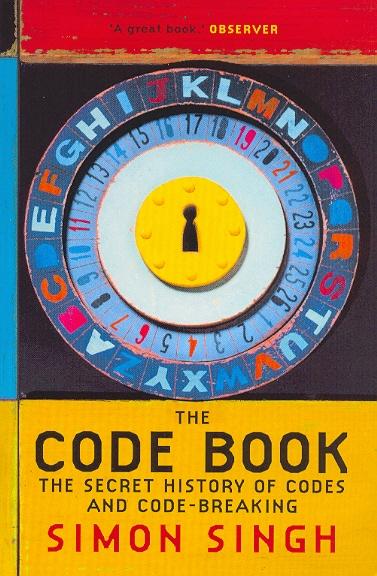
Edward Winter
From José Fernando Blanco (Madrid):
‘I have been reading an excellent work, The Code Book by Simon Singh, first published in 1999 and with a paperback edition issued in 2000. It describes various historical and current aspects of ciphering and deciphering messages, and one of the chapters deals with the activities of the British intelligence services during World War II, which proved crucial for the Allies’ victory. I quote from page 178 the author’s description of the bizarre mixture of people involved in deciphering enemy messages:
“... in addition to the mathematicians and linguists, there was an authority on porcelain, a curator from the Prague Museum, the British chess champion and numerous bridge experts.”The chess champion is not named, but it would seem to be C.H.O’D. Alexander, who had won the most recent championship, in 1938.
The following page quotes from a letter dated 21 October 1941 written by some of the criptanalysts to the British Prime Minister, Winston Churchill, to appeal for additional staff. It was signed by A.M. Turing, W.G. Welchman, C.H.O’D. Alexander and P.S. Milner-Barry. Churchill immediately issued a positive response.
Milner-Barry (“one of the Hut 6 cryptanalysts”) is cited as follows on page 186:
“I do not imagine that any war since classical times, if ever, has been fought in which one side read consistently the main military and naval intelligence of the other.”’
For another detailed discussion of the work of the Bletchley Park code-breakers, together with the complete text of the letter to Churchill (which was marked ‘Secret and Confidential. Prime Minister only’), see The Essential Turing edited by B. Jack Copeland (Oxford, 2004).
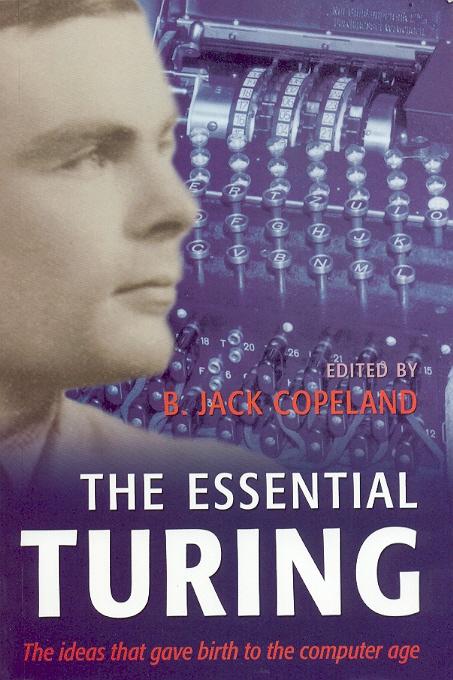
P.S. Milner-Barry wrote about his and Alexander’s code-breaking work on pages 3-5 of Golombek and Hartston’s The Best Games of C.H.O’D. Alexander (Oxford, 1976) and included the following tantalizing comment:
‘Much has been written lately about what came out of Bletchley, but only from the point of view of the user. Security restrictions on the story of the breaking of the Enigma from the technical point of view have not yet been lifted. I still hope that they may be in my time. It would, I believe, make an enthralling story which would be particularly fascinating to chessplayers. For both Hugh and myself it was rather like playing a tournament game (sometimes several games) every day for five and a half years.’
Milner-Barry lived until 1995. Dare it be hoped that he wrote up his recollections of the 1940s?
Harry Golombek, who died the same year as Milner-Barry, was also at Bletchley Park. In his obituary of Jacob Bronowski on pages 441-443 of the December 1974 BCM he recalled being heartily recommended to an Intelligence Department of the Foreign Office by his artillery commanding officer on the grounds that ‘I had too much brains to be behind the guns’. On page 131 of his Encyclopedia of Chess (London, 1977) Golombek stated that he was at Bletchley Park ‘like Alexander, Milner-Barry and quite a number of other chessplayers’. Who were the others?
We note, finally, the following on page 162 of Simon Singh’s book:
‘Initially, Bletchley Park had a staff of only two hundred, but within five years the mansion and the huts would house seven thousand men and women.’
(4029)
Alan McGowan (Waterloo, Canada) writes:
‘See CHESS, February 1945, page 73, for a report of a 12-board match on 2 December 1944 between Oxford University Chess Club and Bletchley Chess Club. The Bletchley team (which won 8-4) included C.H.O’D. Alexander and H. Golombek on boards 1 and 2. Board 3 featured J.M. Aitken, board 4 was I.J. Good, and board 5 was occupied by N.A. Perkins. Full team details were given, as well as a photograph of the players:
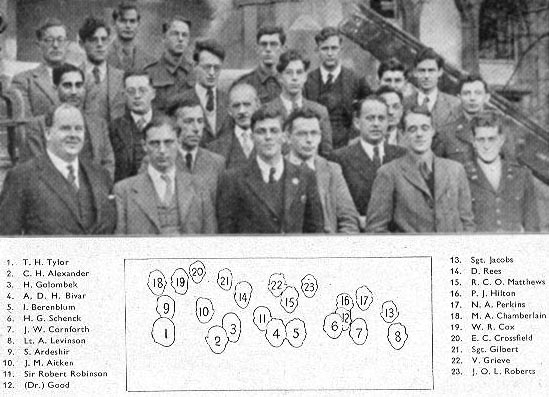
An article based on this information was published on pages 10-11 of Scottish Chess, June 2005.’
Milner-Barry was not mentioned in the CHESS report. As regards his surviving papers, Leonard Barden (London) draws our attention to their location. [Replacement link.]
(4034)
From Calle Erlandsson (Lund, Sweden):
‘The mathematician Arne Beurling (1905-1986) worked with the botanist and correspondence chess grandmaster Åke Lundqvist (1913-2000) on breaking the Geheimschreiber code. Professor Beurling had already solved several Russian crypto systems in 1939-40. After the occupation of Norway in 1940 the Germans insisted on using the Swedish west-coast cable system for telephone and telegraphic traffic. Sweden naturally made formal protests, but it did mean that Sweden could construct a bugging cable to Stockholm. Beurling and Lundqvist understood that there was a machine involved, the Siemens Geheimschreiber, and they eventually broke the code.
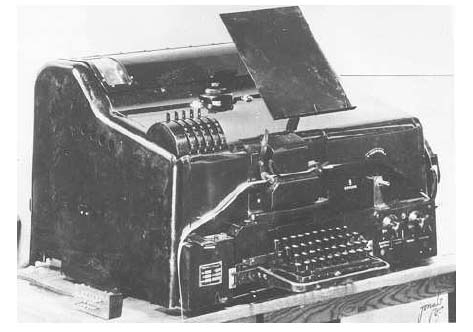
The Geheimschreiber
Bengt Beckman wrote a book about the code-breaking Swedes, which was also published in English in 2003 by the American Mathematical Society: Codebreakers: Arne Beurling and the Swedish Crypto Program During World War II.
Lundqvist played only 87 correspondence chess games in his career (1944-76), with a score of +43 – 12 =32; he was Swedish correspondence champion in 1945. He took part in the world championship finals II-IV, finishing fourth, third and eighth respectively. An obituary of him was published on pages 31-45 of the 6/2000 issue of Korrschack.’
(4040)
The Steinitz-Chigorin code story was discussed on pages 243-244 of Chess Facts and Fables, and C.N. 4421 reported a similar tale regarding Capablanca and Lasker. Now we quote what is termed a ‘Chess Fact’ on page 19 of Chess Attack by Mathew Graham (Woodbridge, 2000):
‘During World War II, the Japanese confiscated chess books thinking they were secret military codes.’
The same claim can be found, without any particulars, on various lax webpages.
(4488)
A paragraph from page 468 of the December 1896 BCM:
‘The long-expected return match between Messrs Lasker and Steinitz, for the championship of the world, began at Moscow, on 7 November, having been delayed a few days owing to a political difficulty. Mr Steinitz had arranged to telegraph the games to America in cypher, which cryptogram, however, had to be submitted first to the censorship of the Russian government, and it took some time to convince the authorities that there was nothing nihilistic in the mysterious messages to be sent.’
(6699)
Further information about Alan Turing and chess is given in The Machine Plays Chess? by Alex G. Bell (Oxford, 1978), and in particular on pages 14-23. See too Alan Turing: The Enigma by Andrew Hodges (London, 2014), which has many references to chess.
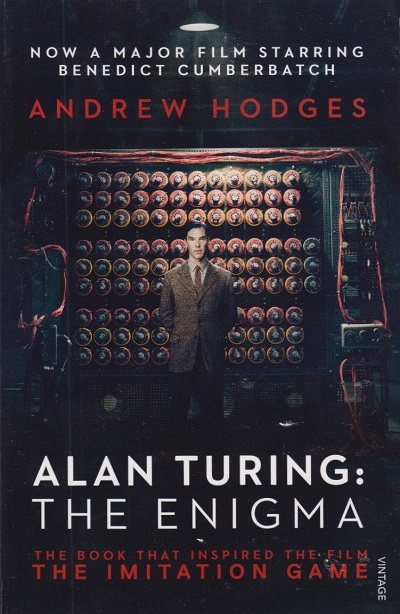
Our feature article Chess and the Code-Breakers, which focuses on the Second World War, prompts Vladislav Tkachiev (Moscow) to ask for information about chess figures who made a contribution, in whatever capacity, to the war effort of any country during the period 1914-18.
(9710)
Addition on 17 April 2020:
Ulrich Tamm (Enger, Germany) provides the following references:
A personal memoir of Alexander by Milner-Barry;
An in memoriam article on Alexander by Hugh Denham.
He also notes that the work of Alexander and Milner-Barry at Bletchley Park was described in the book The Hut Six Story by Gordon Welchman, and in an article by John A.N. Lee and Golde Holtzman, ‘50 Years After Breaking the Codes: Interviews with Two of the Bletchley Park Scientists’, on pages 32-43 of the 1/1995 issue of IEEE Annals of the History of Computing.
To the Chess Notes main page.
To the Archives for other feature articles.
Copyright: Edward Winter. All rights reserved.